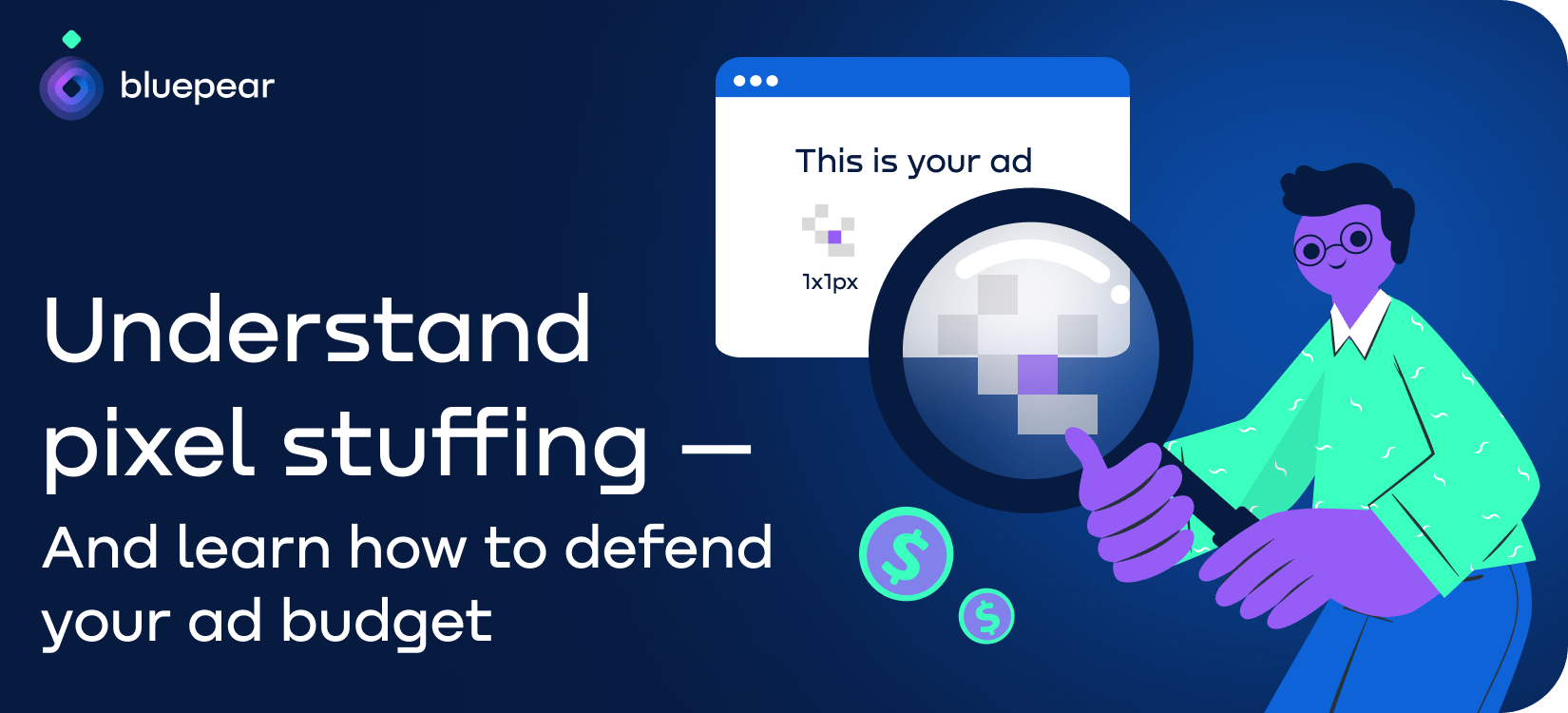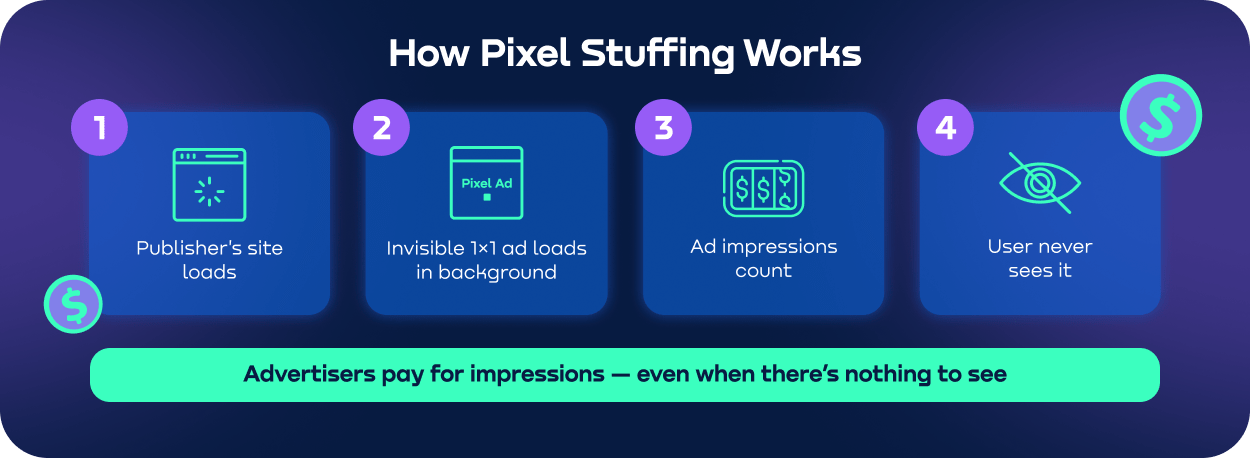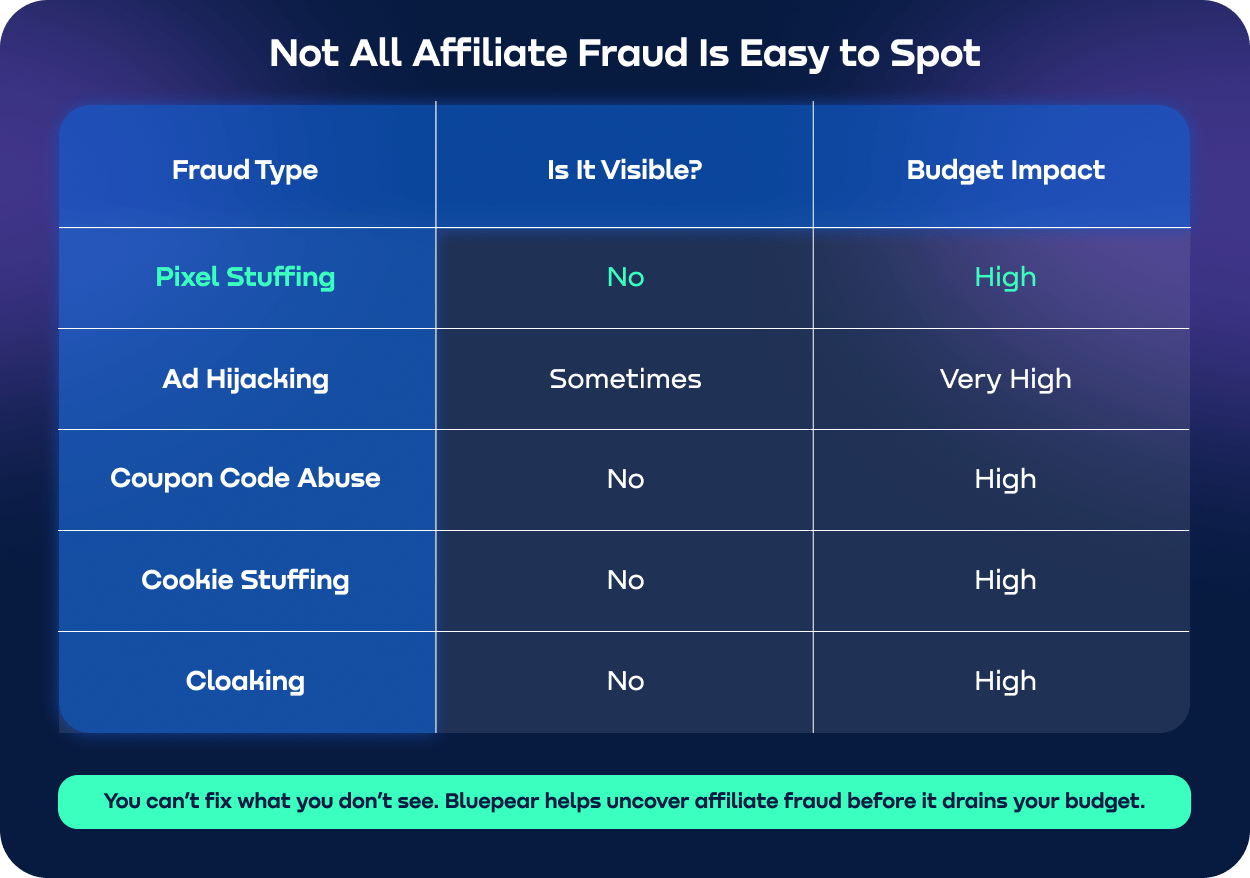
Contents
Introduction
In the world of digital marketing, affiliate campaigns are a key growth driver for many brands. But what if some of that growth is built on invisible clicks and non-existent views? Enter pixel things, a lesser-known yet deeply damaging form of ad fraud — and a major issue in pixel advertising today. While it's not the most common scheme out there, pixel stuff has quietly siphoned millions from advertising budgets — often without anyone noticing. This article breaks down what pixel stuffing is, how it works in affiliate marketing, and what you can do to detect and prevent it. We’ll also show how solutions like Bluepear help defend your affiliate program from more widespread fraud tactics, like ad hijacking, fake pixel tracking, and promo code abuse.
What Is Pixel Stuffing and How Does It Work?
The Basic Concept
Pixel stuffing is a form of ad fraud that hides real ads inside an invisible frame, typically just 1x1 pixel in size — basically the size of a speck on your screen. This means the ad technically loads and "displays" on the page, but no human user ever actually sees it.
So why does it matter? Because most pixel advertising campaigns — especially in programmatic advertising — charge based on impressions, not actual visibility. An "impression" is counted the moment the ad is served on a page, regardless of whether it's seen or not.
Pixel stuffing takes advantage of this by stuffing multiple display ads into these invisible slots. The ad tech systems count them as valid impressions, and the advertiser pays — even though the real value is zero. This is a textbook fake pixel tactic.
It’s a perfect example of a loophole in how pixel advertising works. On the surface, everything looks legitimate: the ad server logs an impression, the publisher gets paid, and the affiliate (if involved) earns a cut. But in reality, it’s all smoke and mirrors.
How It’s Used in Affiliate Campaigns
In the world of affiliate marketing, pixel stuffing is sometimes used by dishonest partners to artificially inflate ad metrics and boost their earnings — often via fake pixel impressions that never reach a real user.
Here's how it typically plays out:
• A rogue affiliate sets up a basic website or landing page — often with low-value content or even scraped material.
• Hidden in the code of that page is a tiny 1x1 pixel iframe, which loads display ads from affiliate programs or ad networks.
• Every time a user lands on the page, these invisible ads are "served."
• The system logs each impression as valid, and the affiliate earns commission or payout — even though the visitor never interacted with, or even saw, the ad.
Because the ads are technically loaded, most tracking systems register them as legitimate views — a classic fake pixel trick. And unless someone inspects the source code or runs a technical audit, the fraud goes unnoticed.
This scheme is especially dangerous in pixel advertising and programmatic media buying, where placements are automated and scale quickly. But it's also increasingly found in affiliate programs, where advertisers rely on third-party partners and don't always have visibility into where their ads appear.

Why Pixel Stuffing Is a Hidden Threat for Brands
At first glance, pixel stuffing might sound like a fringe issue — something that only affects obscure corners of the ad world. But in reality, it's a stealthy and costly threat, especially for brands that rely on performance-driven affiliate campaigns.
This kind of fraud doesn’t just waste ad spend — it distorts campaign data, lowers ROI, and can mislead your entire marketing strategy. Here's what makes it so dangerous: How Pixel Stuffing Damages Campaigns
• Fake impressions inflate reach
On paper, your campaign looks like it’s reaching thousands of users. But those users never saw the ad — they never even had the chance. You’re paying for exposure that never happened, thanks to fake pixel activity.
• Zero visibility = zero engagement
If no human can see the ad, there’s zero chance they’ll click, convert, or even notice your brand. That’s a complete disconnect between cost and outcome.
• Campaign performance gets skewed
With so many fake pixel impressions in the mix, your click-through rate (CTR) and conversion rate (CR) drop — making it hard to tell what’s working and what’s not.
• Budgets go to waste
Instead of funding traffic that could convert, you're feeding a fraud loop. Money meant for growth ends up rewarding dishonest affiliates or fraudsters exploiting pixel advertising loopholes.
• Data integrity is compromised
When impression data is polluted, your KPIs lose meaning. You can’t optimize campaigns if your foundation — the performance data — is fundamentally flawed.
And it doesn’t stop there. Pixel stuffing often works in tandem with click fraud, where bots or scripts simulate user interactions. Together, these tactics create a false sense of success, luring advertisers into scaling campaigns that don’t actually perform — all fueled by the deceptive power of the fake pixel.
Why It’s So Hard to Detect
Pixel stuffing thrives in the shadows — and that’s exactly what makes it so effective. Since the fraud operates entirely behind the scenes, most teams don’t even know it’s happening until the damage is done. Here’s why it regularly slips past detection:
1. No Visual Clues
The key trick behind pixel stuff is rendering a full ad in a 1x1 pixel space — effectively making it invisible to the naked eye. Even if you’re manually browsing a site as part of a QA check, you won’t see anything suspicious. There’s simply nothing to spot unless you’re looking at the raw code.
2. Hidden in Source Code
These fraudulent ads are typically loaded via iframes embedded deep in the page’s HTML or JavaScript. Unless you’re a developer digging into the browser’s DevTools or network inspector, you’d never know an ad was even served. The stuffing is stealthy by design — tucked away in background code that functions normally on the surface.
3. Impressions Go Unchecked
In many affiliate programs, especially those running on CPA models, the focus is on clicks and conversions — not impressions. Since nobody’s paying close attention to impression logs, shady partners can slip in pixel stuff without raising immediate flags. Fraudulent impressions still trigger payments, even though they never deliver value.
4. Standard Analytics Miss It
Traditional analytics tools (like Google Analytics or standard ad dashboards) don’t flag hidden ad placements. They report numbers, not ad visibility. That means pixel stuffing can artificially inflate your reach and impressions — and you wouldn’t know unless you were using a specialized ad verification or fraud detection platform.
5. It Mimics Legitimate Delivery
To make things worse, pixel stuffing often mimics the structure of real ad placements. The ad gets served, an impression is counted, and the affiliate gets paid. On paper, it looks legit — but in practice, it’s wasted on invisible media.
Bottom Line
Detecting pixel stuff requires a technical eye and the right tools. It’s not enough to monitor conversions — you need to verify how and where your ads are delivered. That means using:
• Ad rendering audits
• Real-time ad visibility tracking
• Fraud detection platforms (e.g. DoubleVerify, Integral Ad Science, Forensiq)
• Manual inspections via browser DevTools — if you know where to look
Without these layers of protection, pixel stuffing will continue to bleed your budget — quietly and consistently.
Pixel Stuffing vs. Other Forms of Affiliate Fraud
Pixel stuffing is just one of many fraud schemes plaguing the affiliate space. Here’s how it compares to more frequent and actionable threats:

While Bluepear doesn’t detect pixel stuff directly, it specializes in stopping more scalable and impactful threats — like:
Affiliate hijacking — When bad actors bid on your brand name to steal direct traffic.
Affiliate content monitoring — To catch unauthorized pages using your brand to drive fake clicks.
What You Can Do to Minimize the Risk
Preventing pixel stuffing isn’t easy, but brands and agencies can take steps to reduce the threat:
1. Use platforms with transparent ad verification. Demand visibility into where impressions are served.
2. Run periodic technical audits. Use tools like Chrome DevTools or ad inspectors to spot hidden placements.
3. Set up fraud detection filters. Look for unusual impression-to-click ratios.
4. Ask for detailed reports from affiliates. Look beyond conversions — request impression logs and traffic sources.
5. Limit campaigns to trusted partners. Vet affiliates before onboarding, and monitor their behavior over time.
Fraud won’t disappear completely, but reducing exposure can save thousands in wasted spend.
Conclusion
Pixel stuffing might not top the charts of affiliate fraud techniques, but its stealth makes it particularly dangerous. Because the ads are invisible, it’s easy to miss — and hard to prove. That doesn’t mean you’re powerless, though.
By understanding how these schemes work and tightening your oversight, you can protect your budget and make smarter marketing decisions. And while pixel stuffing is sneaky, more common threats like affiliate hijacking and coupon fraud are both easier to catch — and more damaging at scale.

